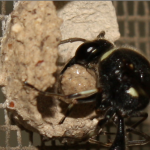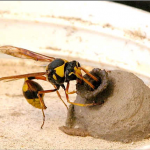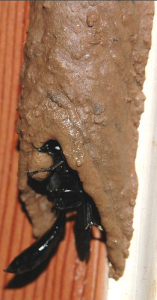Also called dirt daubers or mud wasps the mud dauber can be found through out the United States. Exterminators are often called out to eradicate the wasp but truth be told they are basically harmless and actually beneficial. Besides, why kill the starving artist that’s just trying to rid you of unwanted bugs while making you a beautiful present for your eyes to behold.
Many solitary wasps fall into the group of ‘Mud daubers’ and what distinguishes them is that they build nesting sites out of mud. There is the black and yellow dauber, blue, potters wasp, organ pipe and many more. Usually their name depicts the shape of the nest they build but sometimes it simply refers to their colors or marking.
The dauber may carry it’s construction material quite a distance in the form of a wet mud ball and  then use her mandibles to shape the nest. This mud nest will be a chamber where she will lay her eggs and place paralyzed insects inside for food when the egg hatches. Most are single cell nests so only one egg is laid but she may pack in as many as 15 spiders for the newly emerged larva to eat.
then use her mandibles to shape the nest. This mud nest will be a chamber where she will lay her eggs and place paralyzed insects inside for food when the egg hatches. Most are single cell nests so only one egg is laid but she may pack in as many as 15 spiders for the newly emerged larva to eat.
Daubers can be quite selective in the insects they gather but their main prey of choice is spiders and it may depend on size or kind. The blue dauber is keen on black or brown widows that are not full size yet. When a dauber finds it’s prey she does not kill them but her sting paralyses the insect so that it is fresh when the eggs hatch.
 Other daubers such as the blue may not build a nest at all rather they will invade another nest in which to lay their egg. Daubers also will rebuild or reshape old abandoned nests at times which may be for convenience or perhaps particularly dry weather may mean a shortage of mud.
Other daubers such as the blue may not build a nest at all rather they will invade another nest in which to lay their egg. Daubers also will rebuild or reshape old abandoned nests at times which may be for convenience or perhaps particularly dry weather may mean a shortage of mud.
It’s very rare for a dauber to sting a person even if it’s present while you are removing the nest. Stings usually occur when you handle the wasp or accidently put your hand on one. The nest itself is easily removed by hand or with a trowel but may leave a distinctive outline. In hard surfaces water and a brush will remove this but if it is on your drywall ceiling this might create more of a mess. You may wish to use a small putty knife to scrape away the mud outline being careful to cause as little excess marring of the drywall.
Very little can be done to prevent or control a mud dauber. They are known to build their nests just about anywhere. Tail pipes of cars, under patio furniture, porches, lamps, doorways, storage items in garages or sheds and even in airplane instruments on stored planes. The best you can hope for is to catch them early in the process and remove the nest while treating the area with an aerosol or spray that will chase them away to hopefully a less intrusive spot.
about anywhere. Tail pipes of cars, under patio furniture, porches, lamps, doorways, storage items in garages or sheds and even in airplane instruments on stored planes. The best you can hope for is to catch them early in the process and remove the nest while treating the area with an aerosol or spray that will chase them away to hopefully a less intrusive spot.
If by chance you find one in a place you can live with leave it alone and just visit from time to time and watch the wonderful craftsmanship of a mud dauber. When she is done with her artwork you’ll have the added satisfaction of knowing that there may be 15 or so unwanted spiders all wrapped up inside that you won’t have to deal with. This is a win win because the new daubers will emerge ready to do it all again as brand new aspiring artists.




